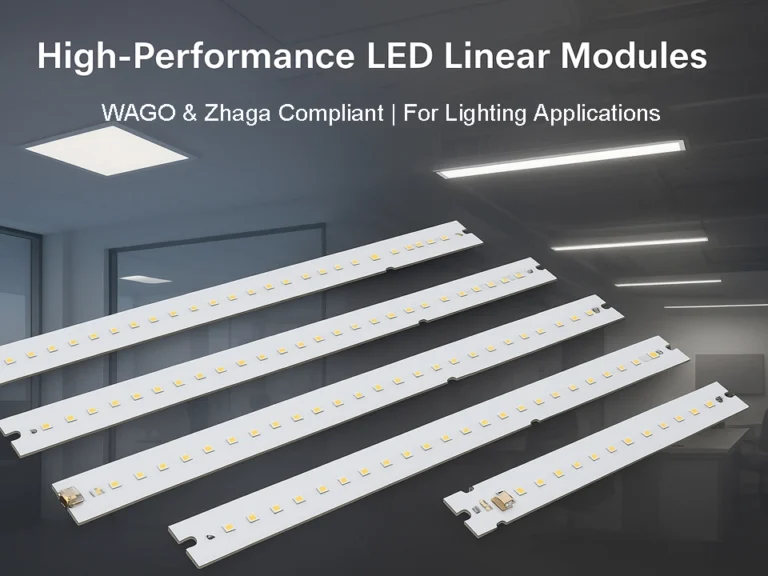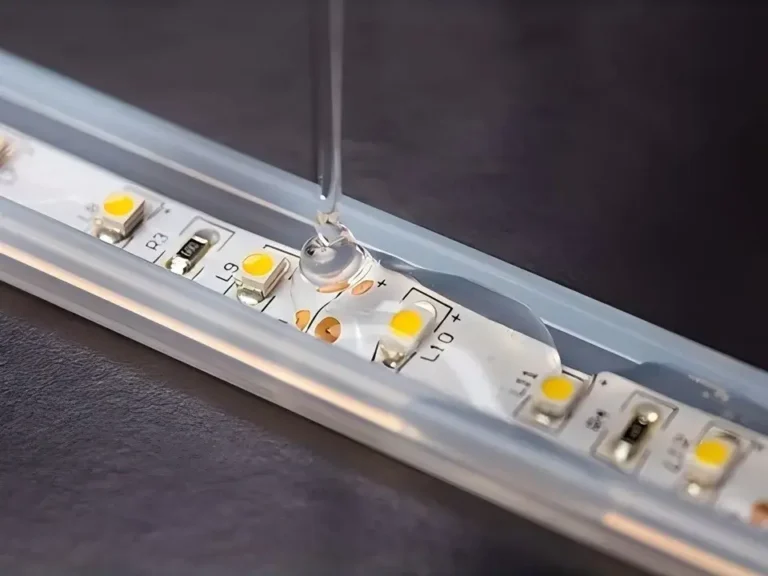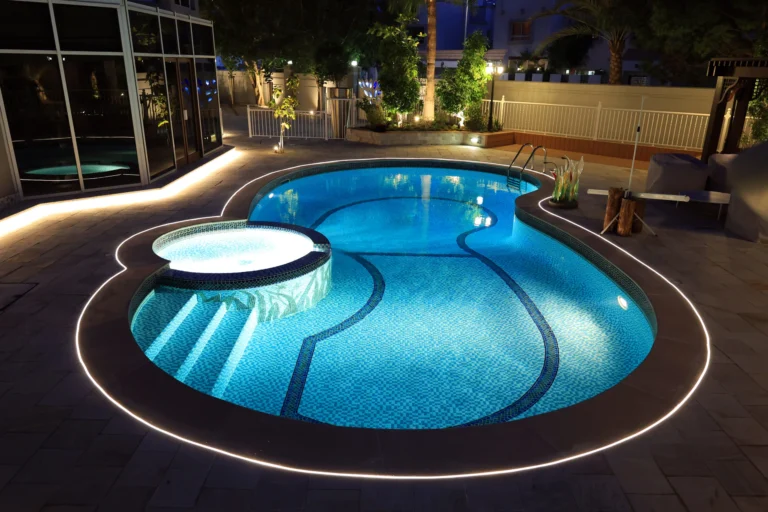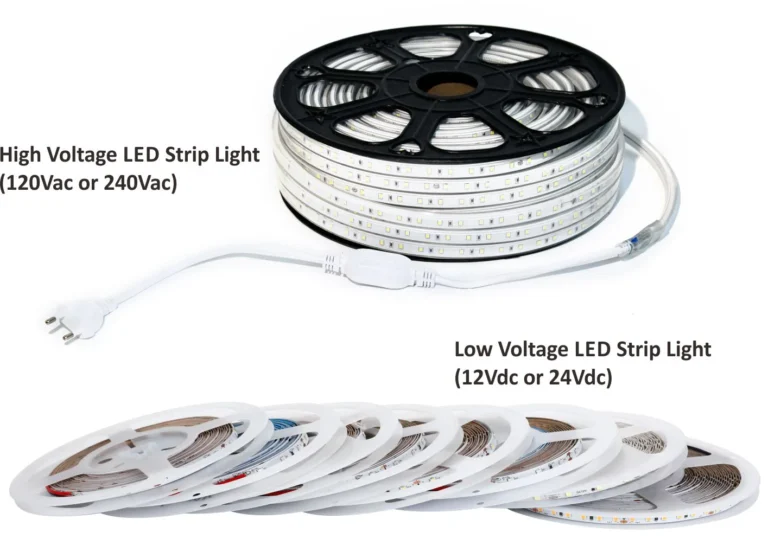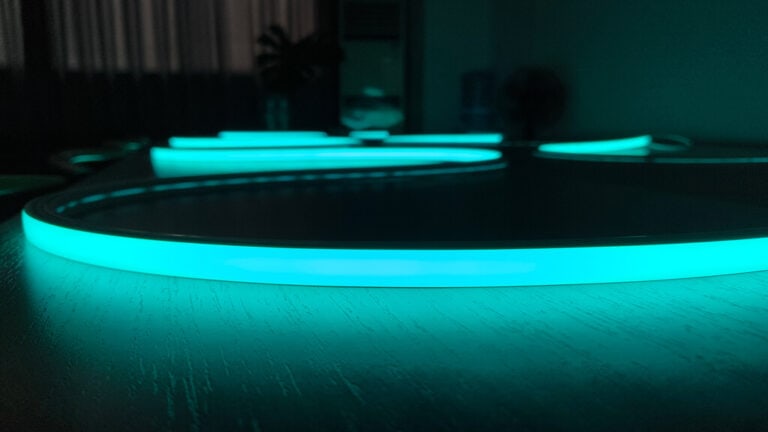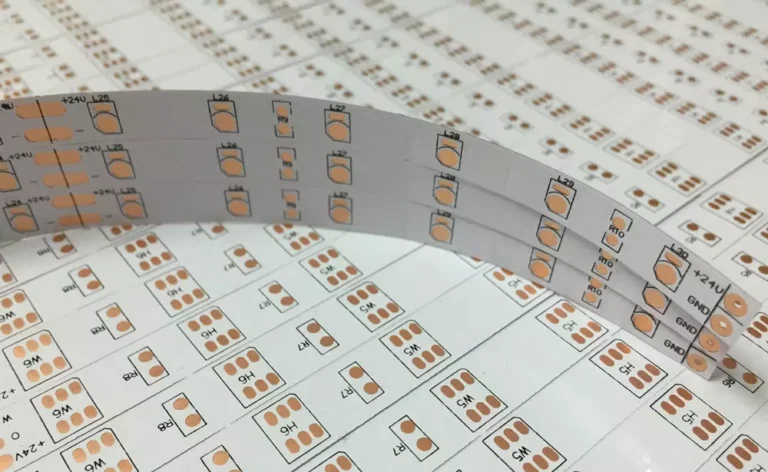随着LED照明技术的快速发展和扎加联盟的新标准, 线性LED模块 现已广泛应用于商业照明、建筑装饰、工业环境中,因为它们提供均匀的光线,可以以不同的方式安装,并且可以轻松更换。
然而,它们的性能和寿命在很大程度上取决于 LED 驱动器的兼容性——不合适的驱动器可能会导致亮度不均、能源效率低下甚至模块损坏。
面对恒定电流、恒定电压和线性选项等多种驱动器类型,工程师和采购专业人员必须根据线性LED模块的电压、电流要求和环境条件准确选择驱动器。
本文提供了涵盖核心参数和拓扑结构的系统选择指南,帮助您实现 LED 线性模块和 LED 驱动器之间的协同优化。
什么是LED驱动器?
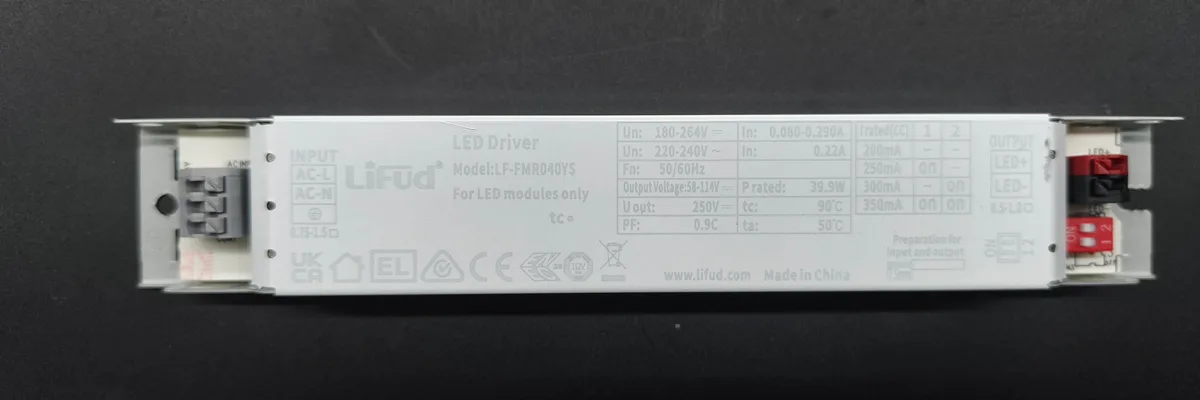
一个 LED 驱动器 是一种专门设计用于为发光二极管(LED)供电的电子设备。 其主要功能是将交流电(AC)转换为LED所需的直流(DC),同时精确控制电流和电压,以确保LED的正常和稳定运行。
除了供电之外,LED 驱动器还必须精确调节电流和电压。 LED 对这些参数的波动高度敏感,即使是微小的偏差也会导致损坏或性能下降。 因此,LED 驱动器需要先进的技术规格和复杂的控制能力。
选择LED驱动器时,必须综合考虑特定LED灯具类型、功率要求和操作环境等因素,以确保选择最合适的驱动器类型。
在 LED 照明系统中,LED 驱动器不仅作为“能源集线器”,为 LED 提供稳定、可靠的电源,而且还作为保护 LED 性能和寿命的关键因素。 高质量的 LED 驱动器可显着提高 LED 灯具的发光效率、稳定性和可靠性,同时降低故障率和维护费用。 这为用户提供了更节能、环保、舒适、便捷的照明体验。
恒流 (CC) 与恒压 (CV) 驱动器
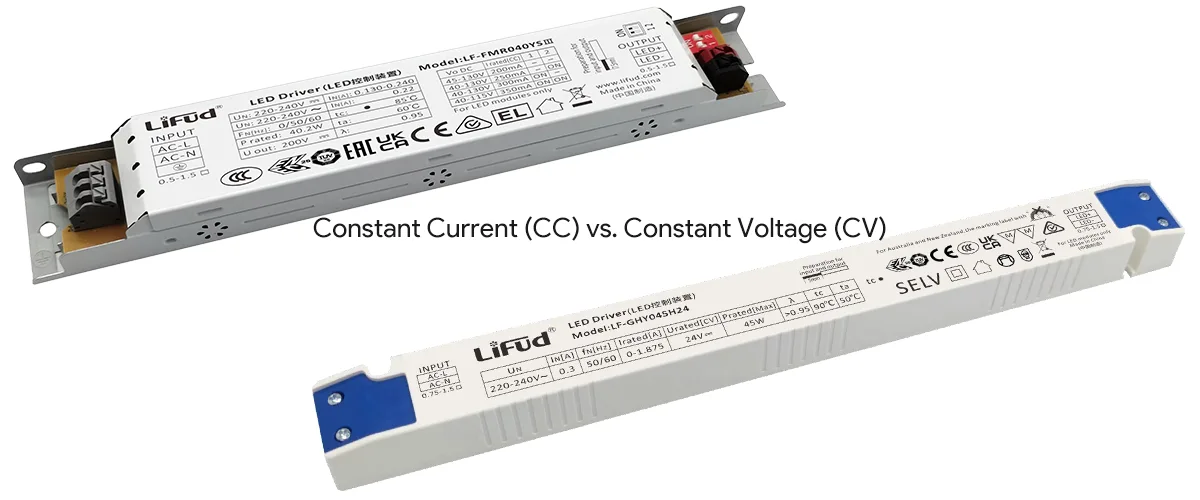
根据不同的应用场景和要求,LED 驱动器有多种类型。 基于输出模式,它们可以分为恒流驱动器和恒压驱动器。
- 恒流优点:补偿LED正向电压随温度的变化,延长使用寿命。
- 恒电压限制:需要额外的电流控制电路设计,提供更低的成本但更高的风险。
选择LED驱动器时,综合考虑LED灯具类型、功率要求和操作环境等因素,以确保选择最合适的驱动器类型。
让我们深入探讨恒流和恒压电源之间的差异:
「恒流 发光二极管 驱
输出稳定电流,而电压随负载变化。 电压通过电流反馈回路动态调整以保持电流稳定性。 例如,当 LED 芯片温度升高而电阻降低时,电源会自动降低电压以维持恒定电流。
恒流驱动器适用于单或多个LED串行驱动。 它们能够实现精确的电流控制,防止亮度漂移和热失控,使其成为 LED 照明的理想选择。 恒流电源严格禁止开路负载(例如,损坏的 LED),但可以通过在短路期间调整电压来保护电路。
「恒定电压 发光二极管 驱
输出电压保持恒定,而电流随负载变化。 电压反馈回路调节输出。 直接驱动LED时,需要串联限流电阻。 然而,电压波动可能导致电流不稳定,导致 LED 过热或烧毁。
恒压电源主要用于需要并行连接的场景,例如 LED 灯条。 它们需要电阻配对并要求高电压稳定性。 恒压电源绝不能经历完全的负载短路或开路,因为这可能会烧毁 LED 灯。
总之,恒流电源在LED模块应用中提供了更高的可靠性,而恒压电源需要仔细的设计和保护措施。
进一步阅读:“恒压与恒流:哪个 LED 灯条最适合商业项目?”
选择LED驱动器的关键因素
1。 电气匹配
在选择 LED 驱动器的输入电压时,请确保其与本地电网电压相匹配,同时考虑电压波动。 电网电压不是绝对稳定的,可能会变化±10%。
例如,在标称 220V 电源的区域,实际电压范围可能为 198V 至 242V,因此所选电源的输入范围必须覆盖这些波动;否则,可能无法正常运行或损坏。
输入电压通常为交流电(交流电),所使用的电压因国家而异。 例如美国和加拿大使用120V,日本使用110V,大多数欧洲国家使用230-240V,以下是不同国家使用的电压参考表:
大多数 N别 V电压 R能量
| 国家 | 电压 | 次数 |
| 中国 | 220V | 50Hz |
| 日本 | 100V | 50/60Hz |
| 丽 | 100V | 60Hz |
| 香港 | 200V | 50Hz |
| 泰 | 220V | 50Hz |
| 印度尼西 | 220V | 50Hz |
| 加拿大 | 120V | 60Hz |
| 阿根廷 | 220V | 50Hz |
| 墨西哥 | 120V | 60Hz |
| 美国 | 120V | 60Hz |
| 关岛 | 110V | 60Hz |
| 意大利 | 220V | 50Hz |
| 德国 | 220V | 50Hz |
| 英国 | 240V | 50Hz |
| 法国 | 127V,220V | 50Hz |
| 希腊 | 220V | 50Hz |
| 瑞典 | 120V、127V、220V | 50Hz |
| 荷兰 | 220V | 50Hz |
| 挪威 | 230V | 50Hz |
| 丹麦 | 220V | 50Hz |
| 瑞士 | 220V | 50Hz |
| 芬兰 | 230V | 50Hz |
| 比利时 | 220V | 50/60Hz |
| 西班牙 | 127V,220V | 50Hz |
| 奥地利 | 220V | 50Hz |
LED驱动器的输出电压必须与LED线性模块的电压相匹配,如下图:由SignliteLED设计的560×24线性LED模块用DC44V电压标示,基于该额定电压,可以选择对应的Leifu FMR040YS电源,其输出电压范围为40V至130V。
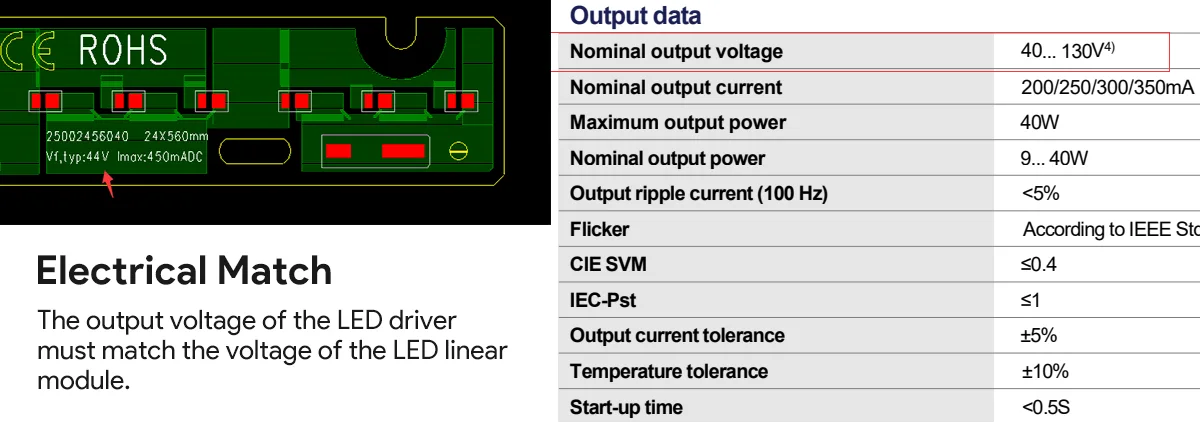
2. 额定功率和效率
额定功率是指LED驱动器在稳定的运行条件下可以提供的最大功率。 驾驶员的额定功率必须符合 LED 灯具的功率要求。 选择驱动器时,选择功率额定值略高于灯具功率的驱动器,以确保边缘并增强稳定性。 例如,35W LED 线性模块应与 35-40W LED 驱动器配对,以避免因过载或欠载而造成的效率下降。
LED驱动器的效率是其输出功率与输入功率的比值,计算为效率(η) = (输出功率/输入功率)×100%。例如,如果输入100W的电能,输出90W的功率,效率为90%,高质量驱动器的效率超过901TP3,像Tridonic,OSRAM,和LIFU 的工作效率一般。
此外,在相同的负载条件下,在较高电流下运行的 LED 驱动器通常表现出略高的效率,而在较低电流下运行的效率略高。 例如,350 mA 驱动器可能比 100 mA 驱动器效率高 1-2%。
选择高效驱动器时,还必须考虑待机功耗。 待机功率是指LED驱动器在断开负载时保持基本功能的持续消耗的电能。 即使没有负载,内部电路也会产生空载损耗(例如,变压器加热)。 欧盟 ERP 指令要求 LED 驱动器的待机功耗≤0.5W,高级驱动器的功率低至 0.3W。
应用建议:
选择额定功率大于或大于 LED 线性模块的 LED 驱动器可确保更稳定和可靠的操作。
此外,使用高效驱动器有助于用户节省电费,减少设备发热和环境影响,并在某种程度上降低驾驶员自身的功耗和热量输出。 对于工业应用,优先考虑 PF ≥ 0.9 和效率≥ 90% 的驱动器,对于住宅应用,重点关注轻负载效率(例如,20% 负载时的效率 > 85%)和低待机功耗(≤ 0.5W)。
3.调光兼容性
线性LED模块通常采用恒流驱动器,其亮度调整依赖于可调光LED驱动器的精确控制。 目前,线性调光驱动器主要包括以下类型:
- DALI 调光:DALI(数字可寻址照明接口)是一种数字照明控制标准,可通过数字信号协议实现对照明灯具的精确控制。 每个灯具或驾驶员单元都具有唯一的地址,支持单独或分组控制。 与0-10V或PWM调光方法相比,它更适合酒店和博物馆等复杂环境。
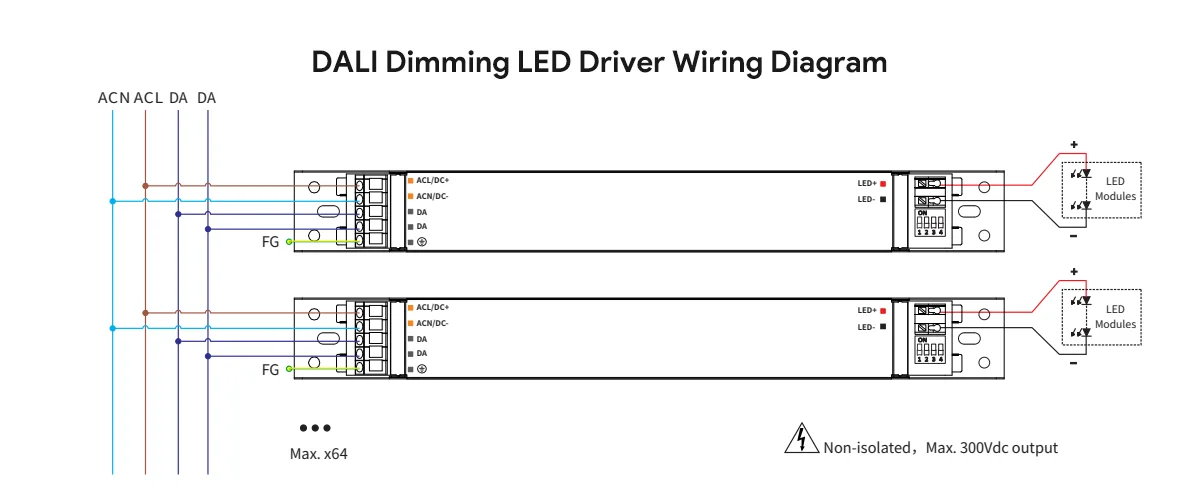
- 3合1调光:三合一调光是一种集成了多种调光技术的集成照明控制解决方案,通常指的是支持 0-10V 调光、PWM(脉冲宽度调制)调光和电阻器(RX)调光的 LED 驱动技术。
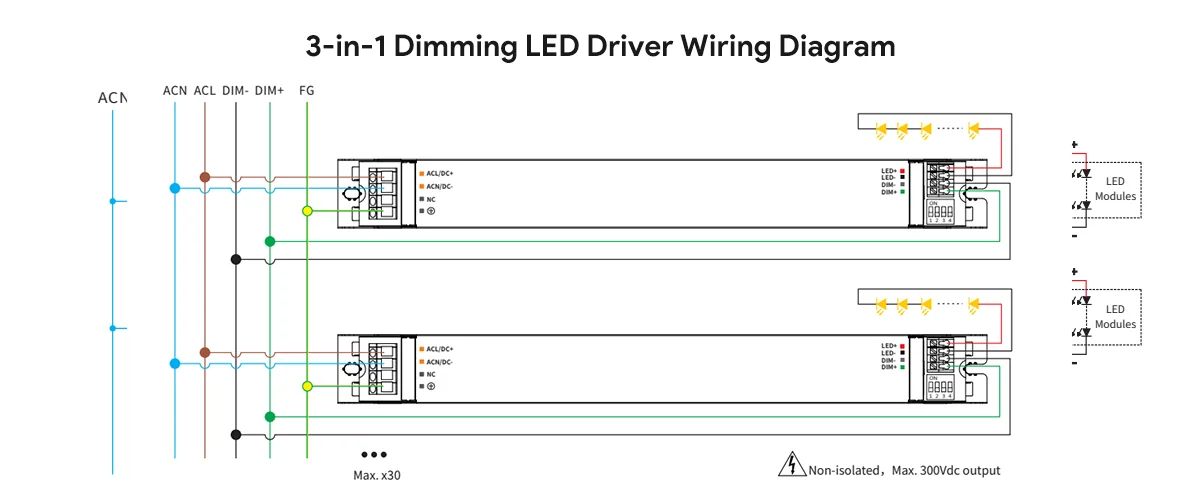
- a) 0-10V调光:通过分类为模拟调光的模拟电压信号(0-10V DC)直接控制驱动电流。 亮度调整依赖于电压变化,无需高频切换。 输出电流由0-10V DC信号控制,在0V时关断灯具,在10V时达到100%的亮度,适用于无闪烁的长距离控制场景。
- b) PWM调光:通过高频切换调节占空比,要求支持 ≥1 kHz 的频率,以最大限度地减少闪烁。 PWM是一种数字调光方法,基本上是在“ON”和“OFF”状态之间交替的脉冲控制。 它适合需要高精度、低成本调光的场景。
- c) 可调电阻 (RX) 调光:通过电位器改变电路电阻以调节输出电流和控制亮度。 特点:电路简单但精度较低,常用于低成本解决方案。
- TRIAC 调光:TRIAC调光是一种通过调整TRIAC(硅控制整流器)的传导角来控制电流幅度的技术。 其核心原理涉及改变每半波交流电源的传导时间(相位角),以调整输出电压的有效值,从而调节负载功率和亮度。 适用于无需复杂布线的简单安装场景。
4. 认证与安全

LED 驱动器的认证和安全对于确保产品合规性、市场准入和用户安全至关重要。 主要全球市场对LED驱动器实施强制性认证,不同的国家需要欧盟CE、德国TÜV和美国UL等不同安全认证。
选择符合当地认证的驾驶员可确保安全和法律合规性。 这可以保护产品免受监管不合规风险,例如货物拘留、罚款或市场禁令。 因此,认证筛选和安全设计优化显着提高了照明系统的整体可靠性。
5. 环境与寿命
LED驱动器的稳定性和寿命直接受操作环境的影响,是决定LED系统整体可靠性的关键因素。 在高温、潮湿或多尘的条件下,内部驱动器组件会加速老化,例如电解电容器中的电解液干燥或金属部件的氧化——导致效率损失或失效。
当长时间高温下,LED驱动器的寿命可能会从理论上的50,000小时缩小到10,000小时以下。 此外,电网电压波动和频繁的开关操作会影响驱动器,进一步缩短其使用寿命。
因此,选择合适的安装环境(例如通风良好、防潮、防尘)和使用高质量的 LED 驱动器可以显着延长系统寿命并降低维护成本。 优化运行条件不仅可以提高驾驶员的性能,还可以确保LED设备的长期稳定运行,最大限度地提高经济效益。
一个驱动器可以运行多少个线性 LED 模块?
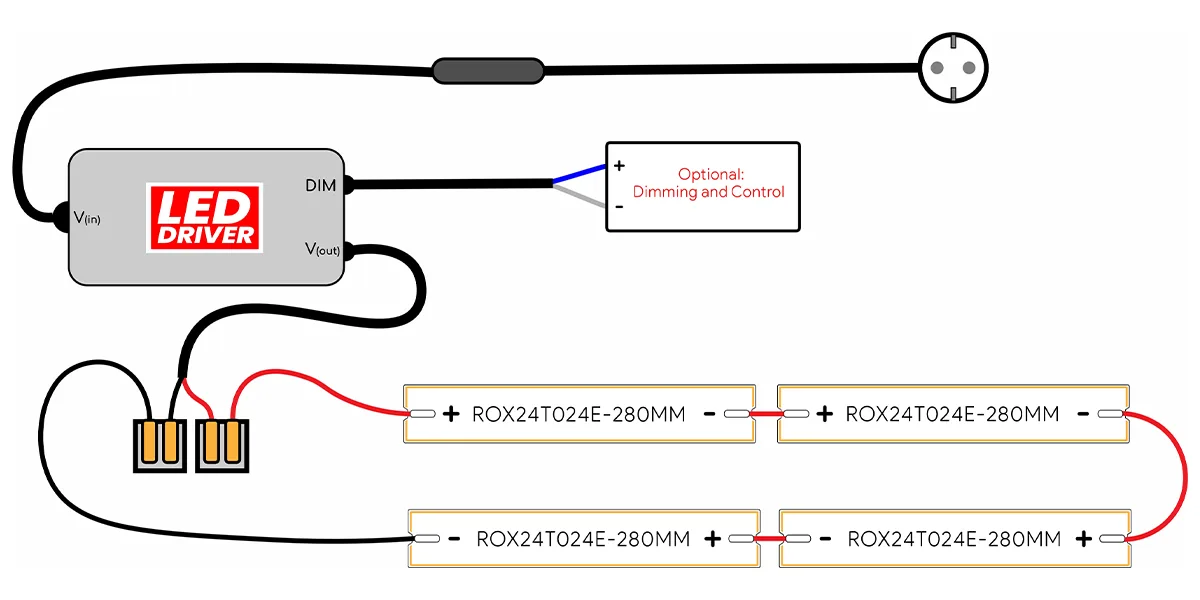
在大多数专业照明系统中,线性 LED 模块采用恒流技术驱动。 这种设计确保了流向每个模块的电流一致,从而实现了均匀的亮度、稳定的色温和延长的使用寿命。
那么,一个恒流驱动器的功率有多少个线性模块? 这取决于模块的工作电压和驱动器的输出电压范围。
1。 确定驾驶员的基本参数
恒流驱动器的两个关键规格是
- 输出电流(mA):例如,350mA、500mA、700mA、1050mA,表示每个模块将携带的电流。
- 输出电压范围(V):例如,DC25–54V,DC176–280V,它决定串联模块的最大总电压。
LED 线性模块必须在恒流系统中串联连接,其中总电压等于每个模块的电压之和。 因此,驱动器的输出电压范围直接决定了您可以串联连接的最大模块数量。
2. 计算系列模块数量
以最常见的 350mA 恒流驱动器(40–120V 输出)为例:
如果单个模块(560mm)的正向电压(Vf)为44V,则大约2.7个模块可以串联:120V ÷ 44V ≈ 2.7 模块。 实践中,建议使用 10% 安全裕度,使 2 个模块成为最佳配置。
只要模块总电压落在驱动器的输出范围内,系统就会稳定运行。 如果电压低于最小启动电压(例如 36V),驱动器将无法启动。 如果超过上限(例如,超过 120V),驾驶员将触发过载保护或出现闪烁。
3. 效率和热设计考虑
LED 驱动器在其整个电压范围内无法有效运行。 一般建议将模块总电压保持在驱动器额定输出的 70%–90% 内。
例如,DC40–120V 驱动器在大约 44–110V 的范围内运行最佳,在该范围内,驱动器实现峰值效率、产生较少的热量并延长了模块的使用寿命。
此外,在单个夹具内串联多个模块组时,建议采用多驱动器分段电源设计。 这确保了所有模块的一致亮度,简化了维护,并促进了电源平衡。
4.基于项目场景优化配置
在项目设计阶段,请考虑以下准则:
- 低功耗模块(<10W):适用于4-6 系列连接,仅需200mA 或275mA 驱动器。
- 中功率模块 (10–15W):推荐的 2–3 系列连接,350mA 或 500mA 驱动器提供更高的稳定性。
- 大功率模块或COB模块:通常只有1-2串联;选择具有高压输出能力的驱动器。
品牌和LED封装的正向电压(VF)略有不同。 因此,在选择之前,请务必查阅模块的数据表,并与驾驶员的输出范围精确匹配。
确定驱动器可以为多少 LED 线性模块提供动力取决于理解:
- 恒流驱动下的模块串联电压堆叠模式;
- 驾驶员的电压范围和安全裕度;
- 整个系统的效率和热平衡。
了解这三个点可以快速识别最佳驱动模块组合。
在 SignLiteLED,我们根据客户提供的驱动器电流参数、模块功率要求和夹具尺寸提供定制的恒流模块解决方案。 这确保了每个线性照明系统在最佳电气条件下运行。
避免的常见错误
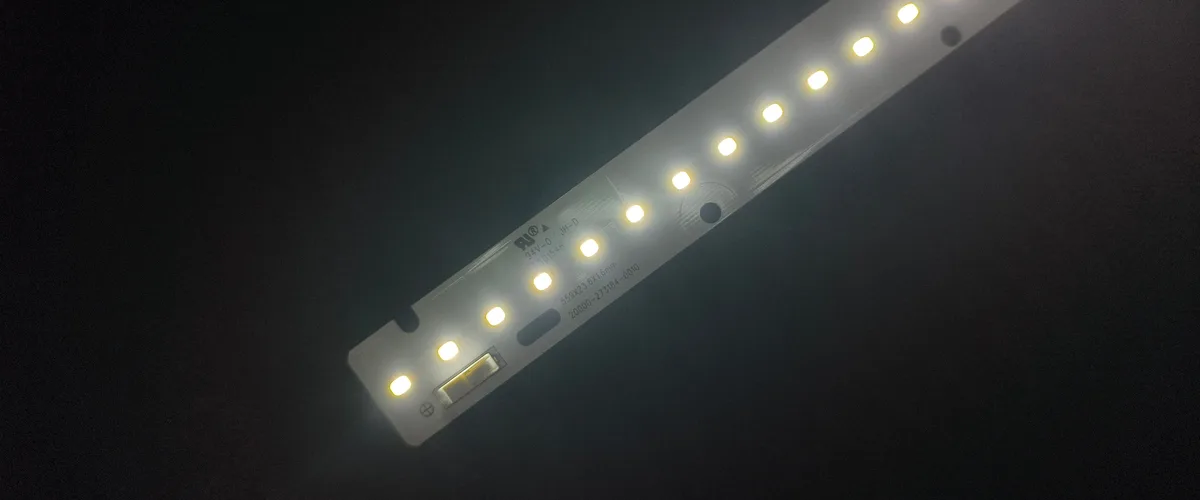
采用线性LED模块的LED驱动器时,必须特别注意电气兼容性、安装方法、散热和信号控制,以确保系统稳定运行。
电压和电流
驱动器的输出电流必须与线性模块的工作电流相匹配。 驱动器的输出电流必须≥模块的总电流(例如,500mA 模块需要额定为 500mA 或更高的驱动器),以防止过载和过热。 超过模块的最大电流额定值可能会烧毁 LED 芯片。
线性模块通常采用低压设计(DC 20V/48V)。 确保 LED 模块的工作电压落在电源的输出范围内。 如果电源的输出电压低于模块的电压,可能会导致 LED 的正向电压 (Vf) 下降,从而导致闪烁。
恒定电流/恒定电压选择
大多数线性模块使用恒流驱动器(100-400mA),而有些模块需要恒压驱动(DC12V/24V/48V)。 根据实际情况进行选择。 混合恒压和恒流驱动器可能会导致亮度不均或损坏模块。
安装和接线
正确连接输入和输出线;反向极性可能会损坏驱动器。 线性模块的串联或并行安装需要专业安装,以防止因连接不正确而造成的非照明或模块损坏。
散热设计
线性模块必须安装在铝基板或散热器上,以防止长时间全功率运行中的光衰减。 对于室外或潮湿环境,请选择防护等级为 IP65 或更高的模块和驱动器。 驱动器外壳必须是防锈的(例如,铝合金)。
调光兼容性
确保驱动程序支持 PWM 调光协议(例如,0-10V、DALI),以防止由不兼容调光器引起的闪烁。
实施这些措施有效地防止了 LED 线性模块和驱动器之间的兼容性问题,延长了系统的使用寿命。
结论
以上概述了为线性模块选择LED驱动器时要优先考虑的几个关键因素。 我们相信这些信息将对您有所帮助。
SignliteLED 专注于创新照明技术,推动照明组件的全球标准化。 我们开发的 LED线性模块 符合 ZHAGA 标准,具有高光效、持久耐用性和灵活的安装。 当前产品适用于各种应用,包括LED线性灯和LED三防灯。
